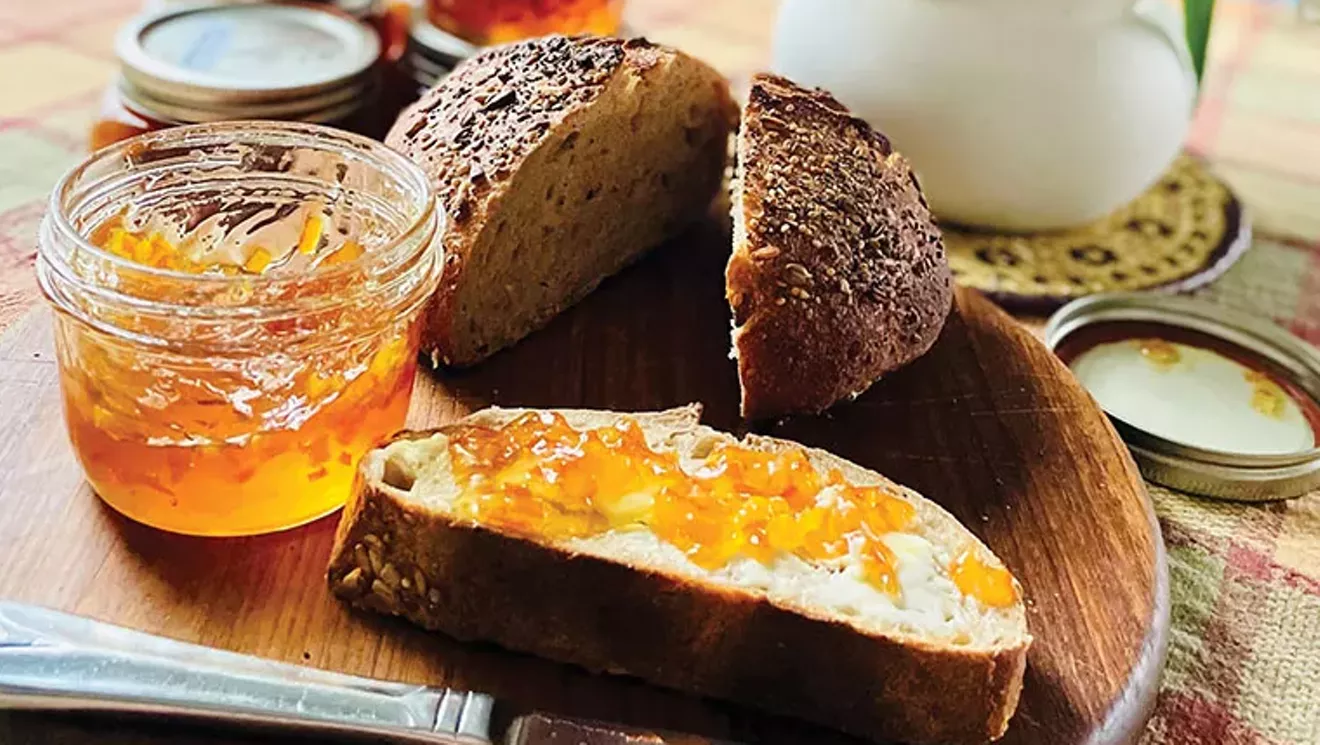
Photo by Ann Shaffer Glatz
Orange marmalade.
The citrus season is in full swing in the southern U.S., and I just returned from our annual Florida vacation with two 15-pound mesh bags of oranges and satsumas. Rather than letting them languish and grow old in my overcrowded refrigerator, I do what I always do when I’ve overbought produce: preserve it! This week, steamy citrus vapors are filling my kitchen, and jars of golden, amber and tawny marmalade are filling my pantry shelves for the year ahead.
Marmalade is a spread most commonly made from citrus fruits. Traditionally made from bitter Seville oranges, modern iterations might include sweet oranges, blood oranges, clementines, grapefruits, limes, kumquats or a combination. Marmalades typically include pieces of the peel and are a bit chunky. Many recipes that use citrus zest or peel advise you to remove the white pith beneath the peel because it contains the bitter-tasting molecule limonin. However, including it in the marmalade gives a nice bitter-sour-fruity flavor experience. The addition of sugar helps balance the bitterness. The pith is also high in pectin. Pectin is a naturally occurring thickener and stabilizer found in the cell walls of most fruits and vegetables. Some fruits and berries have low levels of pectin and require the addition of commercial pectin to make the juices gel, but citrus marmalade doesn’t need added pectin to help it gel.
Growing up, I didn’t like marmalade because of its bitter taste and chunky texture. I was used to the sweetness and smoothness of grape jelly for my morning toast or peanut butter and jelly sandwiches. I was not unique in this regard. Children are born with an aversion to bitter tastes, believed to be a biological adaptation to protect them from ingesting poisons. One’s aversion to bitterness tends to decline during middle to late adolescence.
I first appreciated orange marmalade in the 1970s at Lou Mitchell’s restaurant in Chicago. Lou Mitchell’s is a short walk from Chicago’s Union Station and has been a popular place to grab breakfast or lunch when traveling to and from Chicago on Amtrak. It’s been around since 1923 and is listed on the National Register of Historic Places because of its location as “the first restaurant on old Route 66.” Lou Mitchell’s is known for its hospitality as much as it is for its diner fare. Guests are welcomed with complimentary doughnut holes (and Milk Duds for women and children). Lou Mitchell’s is also known for its homemade orange marmalade, a thrifty repurposing for the byproducts of its fresh squeezed orange juice, and a perfect complement to its toast. It’s so popular that many customers purchase jars of the restaurant’s marmalade to enjoy with their toast at home.
Most citrus is sprayed with a thin layer of wax after harvesting to keep it looking fresh and shiny and protect it during transit. Although the wax is considered safe for consumption, I prefer not to ingest it. The wax coating can be removed by placing the fruit in a colander, pouring over water from a recently boiled kettle, and scrubbing with a stiff vegetable brush under cool running tap water.
Orange marmalade
Makes 4 1-cup jars
Ingredients:
1 pound oranges
1 lemon
4 cups water
3 ½ cups sugar
Preparation:
Put the fruit in a colander, boil some water and pour over the fruit. Scrub the fruit with a stiff brush and rinse thoroughly with cold water.
Transfer the oranges and lemon to a large pot with four cups of water and bring to a boil. Reduce the heat to low, cover the pan tightly with heavy-duty aluminum foil and a lid and simmer gently until the fruit can be easily pierced with a skewer, about 1½ hours. Remove the pan from the heat, cover it and let it sit at room temperature overnight.
Remove the fruit from the pot the next day and reserve the cooking liquid. Transfer the fruit to a cutting board and cut into quarters. With a paring knife, scrape the pulp and pith away from the peel. Place the peel in a separate bowl and return the pulp and pith to the pot with the cooking liquid. Mash the pulp with a potato masher or the bottom of a ladle to release more juice. Bring the mixture to a simmer and cook for 10 minutes.
While the juices simmer, slice the peels into thin strips and cut crosswise into ¼-inch pieces.
After 10 minutes, strain the pulp and juices into a Dutch oven with a fine-mesh strainer. Press the solids with the bottom of a ladle to express all the juices. Add the chopped peels and the sugar to the pot and bring to a vigorous boil, stirring constantly, until the mixture thickens and reaches 220 to 222 degrees. Do not walk away from the stove! Keep your eyes on the pot and adjust the heat to prevent a boil-over. Keep it between 220 and 222 degrees for 15-20 minutes.
Be careful not to overcook the marmalade; it might appear runny when bubbling hot, but when it cools down, it will thicken. Test the marmalade to see if it is ready by spooning a bit onto the plate that has been in the freezer. If it runs a bit, and then stops, it is done. If it doesn’t stop, keep simmering the marmalade for about 10 minutes and retest.
For short-term storage: spoon the marmalade into warm, clean jars, drag a wooden skewer around the inside of the jars and pull upward to remove any air bubbles. Refrigerate and use within three months.
For longer-term storage: wipe the rims clean, cover with the lids and screw the rings on finger-tight. Place in a water bath and bring to a boil for 10 minutes (for elevations below 1,000 feet). Remove from the water bath, cool for 24 hours, remove the rings and check the seals. Sealed jars can be stored for up to a year without refrigeration. Keep the marmalade in a cool and dry place away from direct sunlight until you open it. Refrigerate after opening.


